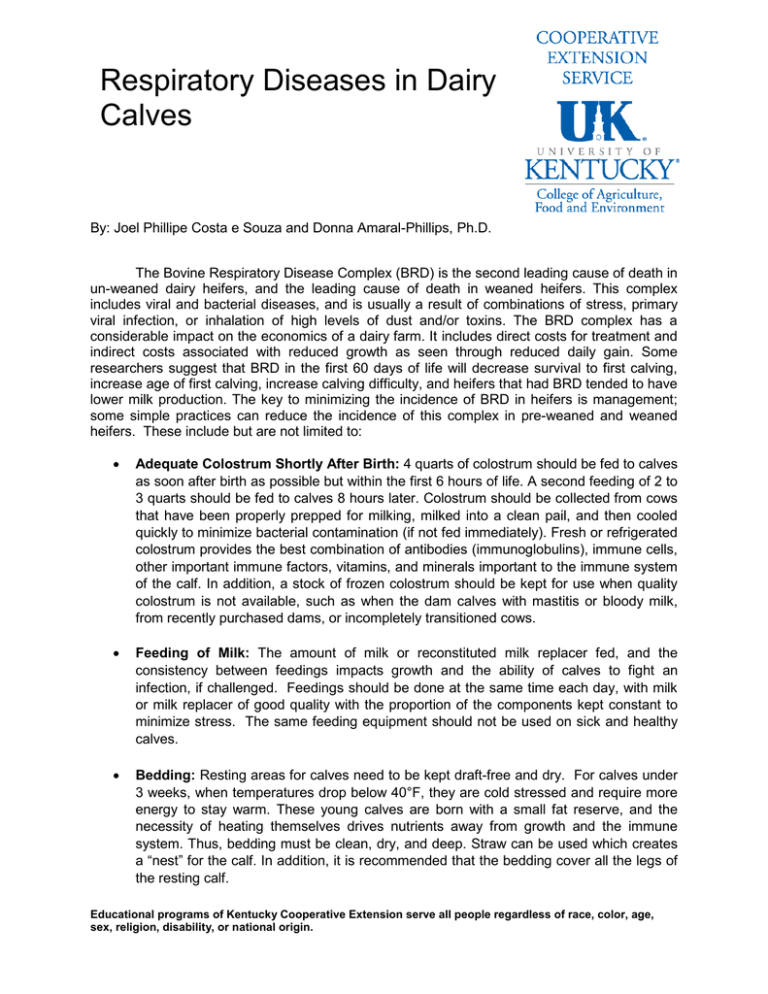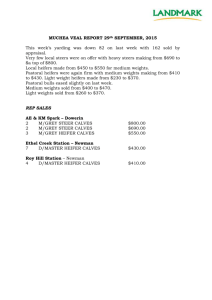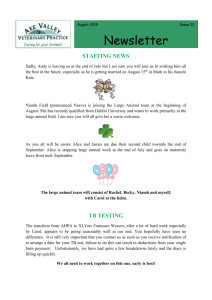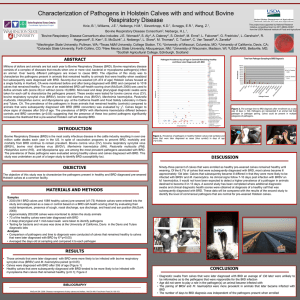Respiratory Diseases in Dairy Calves
advertisement

Respiratory Diseases in Dairy Calves By: Joel Phillipe Costa e Souza and Donna Amaral-Phillips, Ph.D. The Bovine Respiratory Disease Complex (BRD) is the second leading cause of death in un-weaned dairy heifers, and the leading cause of death in weaned heifers. This complex includes viral and bacterial diseases, and is usually a result of combinations of stress, primary viral infection, or inhalation of high levels of dust and/or toxins. The BRD complex has a considerable impact on the economics of a dairy farm. It includes direct costs for treatment and indirect costs associated with reduced growth as seen through reduced daily gain. Some researchers suggest that BRD in the first 60 days of life will decrease survival to first calving, increase age of first calving, increase calving difficulty, and heifers that had BRD tended to have lower milk production. The key to minimizing the incidence of BRD in heifers is management; some simple practices can reduce the incidence of this complex in pre-weaned and weaned heifers. These include but are not limited to: • Adequate Colostrum Shortly After Birth: 4 quarts of colostrum should be fed to calves as soon after birth as possible but within the first 6 hours of life. A second feeding of 2 to 3 quarts should be fed to calves 8 hours later. Colostrum should be collected from cows that have been properly prepped for milking, milked into a clean pail, and then cooled quickly to minimize bacterial contamination (if not fed immediately). Fresh or refrigerated colostrum provides the best combination of antibodies (immunoglobulins), immune cells, other important immune factors, vitamins, and minerals important to the immune system of the calf. In addition, a stock of frozen colostrum should be kept for use when quality colostrum is not available, such as when the dam calves with mastitis or bloody milk, from recently purchased dams, or incompletely transitioned cows. • Feeding of Milk: The amount of milk or reconstituted milk replacer fed, and the consistency between feedings impacts growth and the ability of calves to fight an infection, if challenged. Feedings should be done at the same time each day, with milk or milk replacer of good quality with the proportion of the components kept constant to minimize stress. The same feeding equipment should not be used on sick and healthy calves. • Bedding: Resting areas for calves need to be kept draft-free and dry. For calves under 3 weeks, when temperatures drop below 40°F, they are cold stressed and require more energy to stay warm. These young calves are born with a small fat reserve, and the necessity of heating themselves drives nutrients away from growth and the immune system. Thus, bedding must be clean, dry, and deep. Straw can be used which creates a “nest” for the calf. In addition, it is recommended that the bedding cover all the legs of the resting calf. Educational programs of Kentucky Cooperative Extension serve all people regardless of race, color, age, sex, religion, disability, or national origin. Respiratory Diseases in Dairy Calves • Ventilation within Calf Barns: Calves should not have contact with other calves. This can be achieved by using solid walls. No more than two solid walls should be utilized on the calf pen, with the back and front of the pen allowing for natural ventilation. Ventilation decreases the airborne bacterial counts, minimizing the risks of infection. It also decreases the concentration of ammonia and dust in the air, which can reach the alveoli of the calf’s lung and cause irritation and inflammatory reactions. The ventilation system must provide air exchanges equal to 15 cubic feet per minute. During the winter, the ventilation system must perform 4 air turns per hour, and during the summer a minimum of 30 turns per hour. • Density and grouping: The heifers must be raised in smaller groups (less than 10 animals per group, and at least 22 to 33 square feet per calf). The higher the number of animals in a small area, the greater the chances of spreading disease among calves. When dealing with heifers that were raised individually, keeping the number of animals in the group lower is essential. After weaning these heifers will be learning how to compete with others. This leads to an increased stress condition that can increase drastically the incidence of BRD. Keeping the weaned heifers in small groups is essential since BRD accounts for 46.5% of the death losses in weaned heifers. • Early and Effective Disease Diagnosis: Farmers must be able to identify early the animals with BRD. These animals should be removed from common areas and isolated from healthy calves. BRD is spread by nasal discharge into the air, so an infected animal can spread the disease to healthy calves inside the same barn, or to nearby calves in open areas. Two similar score systems have been developed for scoring calves related to severity or incidence of respiratory disease. One was published by the University of Wisconsin and the other by the University of California at Davis. These visual scoring systems allow the farmer to select animals that need further examination and may need to be treated. The scoring system is based on the appearance of the animal, the presence or absence of nasal and eye secretions and coughing, and rectal temperature. Treatment is not always successful, as some bacterial pathogens are highly resistant to antibiotics. Therefore, the best tool is prevention. In summary, calves must be kept in a clean, dry and well-ventilated environment. Four quarts of colostrum must be offered to the calves within 6 hours of life, the sooner the better. The feeding program must be constant and provide the right amounts of nutrients to the calves. The bedding must be deep to minimize heat loss. The diagnosis of sick animals must be quick and efficient. Calves must be kept in small groups. The farmer must keep things simple, stresses must be minimal, and the changes in feeding program, housing, and group must be gradual. Educational programs of Kentucky Cooperative Extension serve all people regardless of race, color, age, sex, religion, disability, or national origin.




